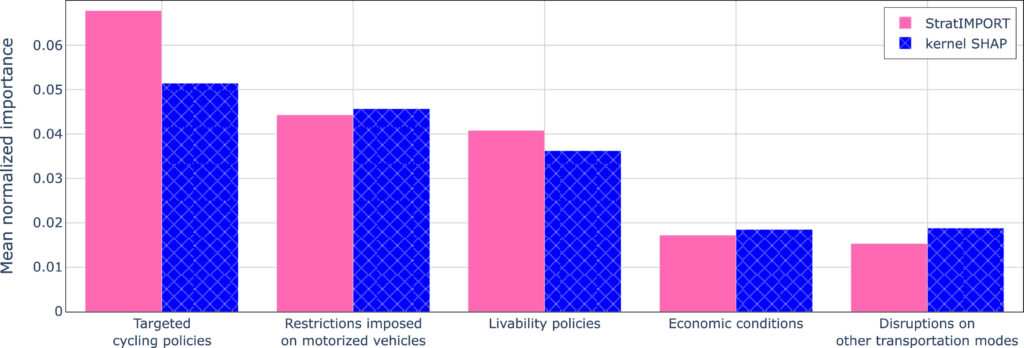Bicycle Lanes Key to Remarkable Paris Cycling Boom

The total length of bicycle lanes is the key factor in the remarkable cycling boom in Paris over recent years.
That’s the conclusion of a study that looked at the increase in cycling in the French capital from 2018 to 2023, using daily bicycle traffic data from the city’s 114 bicycle counters.
Over that period, cycling’s modal share increased from 3% (2018) to 11% (2023), with bicycle trips outnumbering car trips by 2023. Cycling is predicted to further increase to 20 or 30% of all trips in Paris by 2030.
The study evaluates the impact of public policies on bicycle growth in Paris, with variables in five categories:
- Targeted cycling policies
- Restrictions on motor vehicles
- Disruptions to other modes of transport
- Livability policies and
- Economic conditions
The researchers used something called ‘dependence-aware sensitivity analysis’ to assess the contributions of each of the variables on bicycle traffic.
Sensitivity analysis techniques aim to take account of the correlations between different variables and make results more robust and reliable.
The study authors say:
‘Results indicate that local authorities should primarily focus on the development of bicycle infrastructure, including bicycle lanes, parking slots, and effective bicycle-sharing systems.
Bicycle usage can be further expanded by making it more attractive, specifically through the creation of pedestrian zones and green spaces, or the promotion of e-bikes.
Additionally, cycling tends to increase as car usage becomes more difficult…’
Reasons Why Cities Should Want More Cycling
The Introduction to the study explains that transport is the second-largest source of greenhouse gas emissions globally, and the largest source in France.
‘In this context, cycling stands out as a key solution for low-carbon transportation, as it produces no emissions once in use.
As an alternative to motorised transport, it helps alleviate congestion, reduce air pollution, and minimise noise pollution.
Similarly, when replacing public transportation, it can help ease overcrowding, potentially increasing the attractiveness of public transit and further decreasing motorised traffic.
It promotes better physical and mental health, with benefits such as reduced cardiovascular risks and improved mood.
Overall, cycling has been shown to reduce societal costs, with the example of approximately €1 gain per kilometre cycled in the Benelux and North Rhine-Westphalia’.
France is targeting 12% modal share for cycling by 2030, up from 2% in 2019.
Literature Review
The researchers carried out a literature review to understand current evidence about the influences on bicycle traffic.
Temporary factors like weather and the time of year or day of the week have an influence.
However, public policies have the most influence over long-term variations, and the most important factors are targeted cycling policies.
‘Investments in dedicated bicycle lanes have been shown to increase ridership by enhancing both safety and inclusivity, as well as reducing conflicts with motorised traffic.
To be efficient, bicycle lanes must follow a series of rules such as a clear separation from the pavements, a width adapted to traffic, and a continuity of network…’
Other factors are bicycle sharing schemes, the promotion of e-bikes, and secure and accessible bicycle parking.
Restrictions on motor vehicles also increase bicycle usage. This can include Low Emissions Zones and high fuel prices.
Results of the Study

The graphic above shows the study results – the most important factors affecting bicycle traffic, using two different sensitivity analysis techniques.
‘The increase in total length of bicycle lanes is the most important factor in increasing bicycle traffic.
Surveys consistently identify it as the top priority in the region, and additional findings confirm its dominant influence.
This is largely because the presence of extensive bicycle lanes enhances both objective and subjective safety, a critical factor reported to shift towards cycling’.
Bicycle-sharing services like Vélib are popular because they eliminate the risk of theft. Some people only use shared bicycles.
Shared bicycles integrate with public transport.
E-bikes are seen as a good option for new cyclists, to widen the appeal of cycling and make it accessible to more people.
Low Emissions Zones that restrict car use tend to increase bicycle use.
Discussing the results of their study, the authors say:
‘Overall, the results reveal a hierarchy of priorities.
Local authorities should first and foremost focus on bicycle infrastructure, such as bicycle lanes, parking slots, and (well-implemented) bicycle sharing schemes.
Restrictions on motorised vehicles also trigger a shift towards cycling, although they may have social consequences which should not be disregarded, as evidenced during the Gilets Jaunes movement in France.
Restrictions on motorised vehicles rank second in effectiveness…’
The authors add that livability policies such as pedestrian zones and green spaces are variables that also play an important role in the shift to cycling, because they create a more pleasant environment.
Issues associated with public transport play only a minor role.
‘This suggests that people shift from driving to cycling mainly due to rising difficulties in car usage, and from public transportation to cycling due to improved cycling conditions’.

